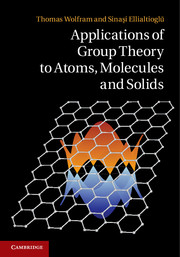Book contents
- Frontmatter
- Contents
- Preface
- 1 Introductory example: Squarene
- 2 Molecular vibrations of isotopically substituted AB2 molecules
- 3 Spherical symmetry and the full rotation group
- 4 Crystal-field theory
- 5 Electron spin and angular momentum
- 6 Molecular electronic structure: The LCAO model
- 7 Electronic states of diatomic molecules
- 8 Transition-metal complexes
- 9 Space groups and crystalline solids
- 10 Application of space-group theory: Energy bands for the perovskite structure
- 11 Applications of space-group theory: Lattice vibration
- 12 Time reversal and magnetic groups
- 13 Graphene
- 14 Carbon nanotubes
- Appendix A Vectors and matrices
- Appendix B Basics of point-group theory
- Appendix C Character tables for point groups
- Appendix D Tensors, vectors, and equivalent electrons
- Appendix E The octahedral group, O and Oh
- Appendix F The tetrahedral group, Td
- Appendix G Identifying point groups
- Index
- References
11 - Applications of space-group theory: Lattice vibration
Published online by Cambridge University Press: 18 December 2013
- Frontmatter
- Contents
- Preface
- 1 Introductory example: Squarene
- 2 Molecular vibrations of isotopically substituted AB2 molecules
- 3 Spherical symmetry and the full rotation group
- 4 Crystal-field theory
- 5 Electron spin and angular momentum
- 6 Molecular electronic structure: The LCAO model
- 7 Electronic states of diatomic molecules
- 8 Transition-metal complexes
- 9 Space groups and crystalline solids
- 10 Application of space-group theory: Energy bands for the perovskite structure
- 11 Applications of space-group theory: Lattice vibration
- 12 Time reversal and magnetic groups
- 13 Graphene
- 14 Carbon nanotubes
- Appendix A Vectors and matrices
- Appendix B Basics of point-group theory
- Appendix C Character tables for point groups
- Appendix D Tensors, vectors, and equivalent electrons
- Appendix E The octahedral group, O and Oh
- Appendix F The tetrahedral group, Td
- Appendix G Identifying point groups
- Index
- References
Summary
The atoms of a crystal execute small, oscillatory motions about their equilibrium positions called lattice vibrations. These vibrations are stimulated by thermal energy or by external agents such as electromagnetic and mechanical forces. As with molecular vibrations, the atomic motions of the lattice can be expressed as linear combinations of the normal modes of motion. Classically, the energy contained in a given normal mode is unrestricted. In quantum theory the energy in a normal mode is quantized in discrete units of ħω. A quantum (ħω)ofenergyin a normal mode of vibration is called a phonon. More loosely, the lattice vibration wave in a crystal is also called a phonon.
Because of the translation symmetry of an (infinite) crystal the normal modes are characterized by a wavevector, k. In the case of lattice vibrations we associate a vector with the physical displacement of each atom from its equilibrium position. The Cartesian components of displacements transform in the same way as the p-orbitals and therefore the application of space-group theory to lattice vibrations is analogous to finding the tight-binding energy bands of a crystal with only p-orbitals on each atom. The method of analysis of lattice vibrations is the same as that employed in Chapter 10 for tight-binding energy bands. Instead of energy bands we obtain “phonon branches”.
- Type
- Chapter
- Information
- Applications of Group Theory to Atoms, Molecules, and Solids , pp. 304 - 336Publisher: Cambridge University PressPrint publication year: 2014



